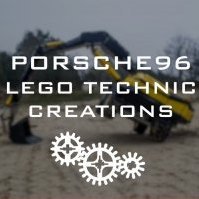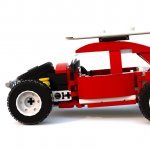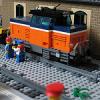Search the Community
Showing results for tags 'Volvo'.
Found 67 results
-
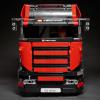
[MOC Fully RC VOLVO EC950EL Excavator
shineyu posted a topic in LEGO Technic, Mindstorms, Model Team and Scale Modeling
Hello Everyone, here is my new MOC: Fully RC Volvo EC950EL with head made big bucket. it has two XL motors for driving, 1 XL motor for XL turntable, 4L Motors for Arm moving. very interested it can play with real soil. Video:- 20 replies
-

[WIP] Volvo EC350E (Cancelled)
JLiu15 posted a topic in LEGO Technic, Mindstorms, Model Team and Scale Modeling
Hey guys, here's a new project I started recently. It is a model of the Volvo EC350E excavator, featuring pneumatics and SBrick control. As of right now I have the superstructure completed. All electronics for the model are contained within here. At the center of the superstructure is a 8043-style gearbox that switches the 3 L motors between left track, right track, and superstructure rotation, respectively, and boom valve, jib valve, and bucket valve, respectively. A M motor powers the gearbox shifting and the pneumatic pump simultaneously. This is possible thanks to a clutch gear on the gearbox shifting mechanism, allowing the motor to drive the pump even when shifting is complete. This will be my last MOC before I go off to college. I move in next Thursday, so I'll try to get at least most of it done before I leave. I won't be building as much anymore with college starting - maybe a MOC or two over breaks. However, if I don't get this MOC done before I leave I'll try to finish it in small increments in the weekends I come home. Photos: -
Volvo H9X Specification of the excavator Length 60s / width 31s / height 20s (47/24,5/16 cm) - without excavator arm Max dimensions of excavator arm: 60x35 cm(length x width) Weight: 3637 g Front suspension: none Rear suspension: none AWD Steered both axles Power - 2x 8878 BB 3x M 4xL 2x XL 3x Servo Specification of the trailer Length 55s / width 25s / height 17s (44/20/13,5 cm) Weight: 1398 g Power: 1x 8881 BB 1x XL Functions Driving - 2x XL Steering - M Gearbox - M Lifting the blade - M Excavator rotation - L Movement of the arm - 3L + 3 Servos Lifting the trailer's tipping bed - XL Today, I want to present wheeled excavator Volvo H9X with trailer. Model was built for Lego contest „Build the construction machines of the future”. Later it received many improvements… In short: it is wheeled excavator without operator’s cabin. I didn’t pattern the model on any real machine. As a scale I took Claas’s wheels. For driving there are two XL motors, which drive the 4 wheels, through two-speed gearbox. First gear ratio is 5:1, and second 1,8:1. The gears are changed by M motor and two 1x7 racks. Both axles are steered by M motor with gear ratio 3:1. In the front there are blade, driven by another M motor. In the upper part of the excavator there are three comperssors for three pnematic functions. First, which drives the four big pnematic cylinders, consists of L motor and two pnematic pumps. Next two compressors are the same (L motor + one pump) and they drive the pneumatic cylinders for moving second section of the arm and the bucket. The valves are steered by three Servos. For excavator rotation I used L motor with gear ratio 155:1. In the front there are double Led lights, powered by a switch. The trailer is a simple liftarm construction. The bed is tipped by one linear actuator driven by XL motor. It is powered by switch, because of lack of free channels on the IR receivers. Gallery
-

[MOC] 1:16 Volvo FMX with Palfinger PK78002 SH
dikkie klijn posted a topic in LEGO Technic, Mindstorms, Model Team and Scale Modeling
The Volvo FMX is an oddly styled truck, its bulldog nose like design stood out to me instantly. Having an inherent weakness for the odd I decided to build one all the way back in 2015. Four years later I proudly present my latest model :). Developing the Palfinger crane took the better half of the development time for this model. In order to house all the electronics necessary a flatbed truck design was chosen with 4 axles, 2 under the bed and 2 to support the crane and cabin. The crane is operated by 3 servo-controlled pneumatic switches, the newer style switch allowed me to build this more compact than we ever could! The Pneumatic cylinders for the extension sections have been modified to allow for a more realistic reach. Two original cylinders were cut and acetone welded together for each one of them. The compressor is powered by an L motor and assisted by a rubber band to reach the pressures necessary to operate the crane. The crane is able to reach the back of the bed, as was my goal, but isn't able to lift much anymore then, the limit of pneumatic control is really stretched when a single-cylinder needs to push an arm of 30+cm on a point 5 studs away from the pivot point. With all this functionality, details are fun but also frustrating to add. Two tiny tool compartments have been fitted on the rear of the truck stowing away lifting equipment. The engine is only built for the upper 2/3 to accommodate for the suspended axles and steering mechanisms. The model is also fitted with a full custom led kit. A custom electronics board with an Arduino pro mini takes the signals from the Sbricks and converts them into turn signals, driving lights, hazard lights and much much more. More can be seen on the Flickr album and in the Youtube video! -
Hello everybody, during this holidays I purchased the 42081 and decided to build it a little different. First, I made some minor changes in design, to look a little more similar to the "real" Zeux. I changed some color here and there; the yellow panels in the middle are different; the placement of the "02" adhesives is on the lower DBG panels instead of the upper ones. But the biggest MOD was to add the pneumatic system, with motorized pump, instead of manual LAs. The valves are located on the sides of the loader, 2 on the left and 2 on the right. There are 2 big cilinders (to rise the arm and the rear axle) and 2 medium (old) cilinders, to operate the bucket and the counterweight. Here you can see the last cilinder, the pump and the motor, located below the battery box: And here is a short video:
-
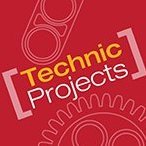
[MOC] Volvo L 350H wheel loader
mpj posted a topic in LEGO Technic, Mindstorms, Model Team and Scale Modeling
Hello! In march I completed my latest Moc, and today I took some photos. It's a wheel loader Volvo L 350H in 1.22 scale. It is an updated version of L 350G by Lego, which I used as parts pack. The bucket is in 1.22 scale, so I decided to build in this scale. I used XL motor for driving, and M motor for steering, by 2 mini LAs. Arm and bucket are controlled by L and M motors, and they have quite good movement range. Battery box and receivers are inside the bonnet. The tyres are third party, 96mm diameter. Sticker are home made! I hope you like it!- 10 replies
-
- volvo
- wheel loader
-
(and 2 more)
Tagged with:
-
Hi Again, I can not find an unopened boxed set of 42030 in perfect condition. I of course will pay as long as the price is not "over the clouds". I live in Istanbul. Can anyone help me in this? Many thanks in advance, Idris PS: The admins can lead me to a "buying-selling" topic, if any, because I couldn't find one as a newbie.
- 14 replies
-

[WIP] Volvo L350H
grego18f posted a topic in LEGO Technic, Mindstorms, Model Team and Scale Modeling
Hi, I recently went back to Lego after a while and have decided to try replicating the new Volvo L350H wheel loader. This MOC is meant to fit the scale of my improved Mack Anthem (dimensions corrected): So, it is roughly 1:22 scale. The finished product will be red (yeah, another red loader) and will be equipped as the one above.All of the functions will be manual, except the arm movement operated thanks to Power Functions. I have obviously begun by the front end of the loader. This was quite hard for me to put all the functions in, as the quasi-vertical cylinders, while keeping proportions correct. The front is quite robust, and functions run smoothly. I think I manage to get a correct Z linkage (see photos). I am now building the rear part of the loader. It will have a 42078 inspired engine as I think the Lego cylinders are way too big for this scale. In addition, there will be a pendular axle and easy battery replacement. Mechanical functions will be operated by an L motor via gearboxes. In the following photos, you can see how I progressed. At this stage, there is mainly beaming to delimit the spaces (cabin, trunk, etc). At first, I wanted to put two two-way gearboxes, but it resulted that I have not enough room because I am limited to 7 studs wide in most parts of the loader (this is partially due to the 94.8 wheels and scale). I ended up with a simple gearbox... Be aware, the gears are not held properly, but I just wanted to show the routing. This one is meant to reduce the number of gears and thus maximize lifting capacity. https://bricksafe.com/pages/grego18f/mack-granite/volvo-l350h If I submit this loader at its early development stages, this is to obtain your feedback. I really think there is room for improvement (and maybe two-way gearboxes!). So, any suggestion is welcome. At the same time, I am reworking the lower central articulation. In the previous iteration, I realized there would be 2 studs ground clearance. That is why I ended with the actual design (allowing 3 studs ground clearance). I am not yet satisfied with the connection because it limits the lateral movement of the U-joints… That’s all for now ? -

[MOC] Volvo Articulated Truck (42043 C-model)
ace_klimax posted a topic in LEGO Technic, Mindstorms, Model Team and Scale Modeling
Inspired by official lego model 8264 Hauler with enhanced functions: * Openable hood with fake 3-piston engine (driven by front wheels) * Independent rear swinging suspension * Articulated chasis with big and small turntables in the centre - HOG controls turning, tilting of the model copies surface it runs on * Bigger manually operable dump bed with automatic closing back side via string * white bodywork, black cabin, gray dump bed There is no motor and battery box (as in original model), I wanted to have all functions operated manually, it gave me place to create exhaust system behind the cabin Except parts from 42043 set, you would need at least 30cm string 74 pages of generated instructions (A4 landscape orientation) details and instructions: https://rebrickable.com/mocs/MOC-23454/klimax/volvo-articulated-truck-42043-mercedes-benz-arocs-3245-c-model-inspired-by-8264-hauler more pictures: https://bricksafe.com/pages/klimax/volvo-articulated-truck-8264-alternate-42043-c-model Model sturdyness tested by 3 years old child :) -
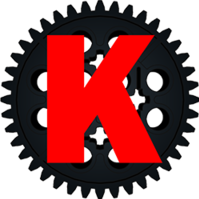
[MOC] Volvo Mars Mission
KirTech LAB posted a topic in LEGO Technic, Mindstorms, Model Team and Scale Modeling
The topic is updated with detailed review: Hi! I’m glad to show you my new MOC made for Lego and Volvo contest. The task was “Build construction equipment of the future”. My little pet was designed special for Mars developing. Artificial intelligence allows this machine to perform different operations simultaneously. This monster replaces excavator, loader, tunneler, dozer. It can be used for road construction, tunnel boring, preparation of construction sites and many other tasks. All-around lighting system and cameras form 3D vision of the surrounding scene in a wide electromagnetic spectrum. Because of low solar irradiance on Mars the machine is powered by a compact nuclear reactor. Model features: 100 x 36 x 45 cm, weight - 7.4 kg. The model contains 16 motors. 1. Chassis - All-track drive (4x XL-motor) - Independent steering for crab mode up to 90 degrees and zero turning radius (4x M-motor) - Central pylon has an automatic leveling system. The tilt sensor is the weight on a pendant. If lengthwise tilt occurs the weight turns the motor on (buggy motor, I just have no wires for PF motors). The motor is interfaced with four linear actuators which level the superstructure - Central pylon has two co-axial independent turntables for different equipment 2. Loader - 360 degrees rotation (M-motor) - Boom lifting mechanism (L-motor) - Boom extension with synchronized counterweight movement (mechanical binding, M-motor) - Bucket loading and unloading (M-motor) 3. Tunneler - 360 degrees rotation (M-motor) - Boom tilting mechanism (L-motor) - Drilling head has five types of movement (XL-motor). The central part rotates fast in forward direction, the second part – in opposite direction, the third part – slowly in forward direction, eight additional cutters rotate in perpendicular plane. In addition, the whole drilling head unit moves in a reciprocating manner like a puncher - Because of absence of liquid water on Mars I suggest to use a huge vacuum cleaner to remove dust from drilling (you can see six working propellers near the drilling head) All the functions have remote control except for the leveling system – it operates automatically. Please enjoy the video: Thanks for watching! -
Now 99% happy with this, my interpretation of a backhoe excavator, based originally on the red farm tractor by TLG and evolved from there, enjoy, hope you like it like me, comments feedback welcome.
-
Hello! I show here my entry to the latest Lego Ideas contest: the Volvo Excavadrone. This project born in my mind in the middle of the contest: at the beginning I was thinking about a modular construction machine, but it was not something “special”. Then I started thinking out of the box, and a flying machine was born! All functions are manual: Arm and bucket movement, with 3 Las Turret rotation Solar panel movement Flipping wheels/propellers Detachable operator cab Independent suspensions The model was a runner up winner of the contest, so I’m really proud of it. I hope you like it too.
-
REVIEW - 42081 - VOLVO CONCEPT WHEEL LOADER ZEUX INTRODUCTION Cranes, forklifts, cars....can we please get something different for crying out loud?! Well....here it is, something different. Of course, one can argue that this is yet another a front loader, and technically they might be right. But it is a unique in a way. Volvo and TLG make the most of their ongoing collaboration and present us the ZEUX, an Autonomous Concept Wheel Loader. An autonomous car (also known as a driverless car, self-driving car, and robotic car) is a vehicle that is capable of sensing its environment and navigating without human input (source wikipedia). This boils down to the front loader being capable of navigating without human input, therefore lacking the cabin. In order to perfectly sense the environment, it uses a drone sidekick! Some people think this thing is as ugly as....an autonomous concept wheel loader, but I will tell you straight away I absolutely love it. I love the concept, I love the looks and I love the fact that TLG and Volvo actually made a Technic set for this vehicle. And that's that for an objective review. Of course, I will try to be objective in my review, but I won't hide the fact that I am very enthusiastic about this model. Let's deploy the drone and....grab a beer, since this thing will be driving itself. If you see this icon, you can click the image on the left or right side of the image, to cycle through alternative images. PICTURES Pictures can be clicked to view hi-res versions. More pictures can be found in my Flickr album. DISCLAIMER This set has been provided by the CEE Team of TLG. It's not my goal to promote this set. It's my goal to give you an honest opinion about it. Therefore, the opinion in this review is my own and is in no way linked to TLG. SET INFORMATION Number: 42081 Title: Volvo Concept Wheel Loader ZEUX Theme: Technic Released: 2018 Part Count: 1.167 Box Weight: 2,33 kg Box Dimensions: 57,5 cm x 37,0 cm x 11,1 cm Set Price (MSRP): £ 109.99 / $ 139.99 / € 119,99 Price per Part: £ 0.09 / $ 0.12 / € 0,10 Links: Brickset, Bricklink THE BOX The front shows the model with its flying sidekick. The background shows a pile of sand and behind that a skyline with scryscrapers. Apparently, this vehicle is not only meant to be used in remote mining facilities, but also in urban areas. The bottom right tells us the vehicle measures 59 cm in length. If you don't own the 42030 - Volvo L350F Wheel Loader, but you do want the big bucket, now's your chance. You will get four nice big Claas tires with it, in case you missed those. So, this set might be interesting enough for the unique parts alone. BACKSIDE The back is divided in two sections, a top section for the main model and a bottom section for the B-model, another Volvo Concept, called the PEGAX. Needles to say, I am more enthusiastic about this alternate model, than the one for the Rough Terrain Crane. I actually quite like this one, but more on that later. CONTENTS OF THE BOX This box contains: 1x Sealed pack with booklet and sticker sheet 4x Tires 1x Big bucket 1x Bag with rims, actuators and gear rack housing 9x Unnumbered bag BUCKET AND TIRES I didn't think to see another set with the big bucket, but here it is. And four Claas tires, which are turning into a common presence in my collection. I absolutely love these bad boys and I sure hope TLG will some day release a smaller version as well. RIMS AND ACTUATORS A bag containing four rims, two linear actuators and a gear rack housing. BAGS A total of nine numbered bags. HIGHLIGHTED PARTS I was about to show the pictures of the bucket and rim again here, but that's rather useless, since I already posted them in the content section. Other than those parts, there aren't any new or interesting parts. I can hightlight the propellors, but that's about it. 7 BLADE PROPELLOR This propellor in flat silver isn't very rare, but you don't see it every day either. Comes in seven other sets. PART LIST Two pages showing the 1.167 parts. THE BUILD We start by building the front of the chassis. An interesting technique is used near the gear rack. The white part behind the 12T Gear is not a 1L connector. It's actually a 2L Liftarm with Pin and Axle. It rotates between two 5L thin liftarms. I could be mistaken, but it's probably just for proper alignment of the front and rear wheels. Here's a better view of the 2L Liftarm. I should have taken a better picture. REAR The rear wheels are connected to this assembly. Both the front and rear wheels don't implement shock absorbers or any other form of suspension. When you operate the final model, you are inclined to push it down to test the suspension. Unfortunately, to no avail. I reckon autonomous vehicles don't need suspension BOOM This is the boom which will connect to the bucket. Operated manually via a Linear Actuator. Usually manual operation and LA's don't combine very well, because it makes operating the functions very cumbersome. I wonder if this is the case for this vehicle as well. And the boom connected to the chassis. This is actually turning into some sort of vehicle. Feels more like an excavator than a front loader, but that will probably change in a bit. Next we are going to build the.....the.....uhmmm......what is it that we are building here?! It does seem to be sliding out. Ahhh here it is, the....uhmm.....the.....counterweight I presume. This entire big block can slide out to compensate for the weight of a filled bucket. T = F x L comes to mind. Looking at the left image, you see three (six, if you count the other side as well) panels with stickers, red and green lights and "chromed" grills. A couple of steps further down the road you will cover them with other panels (image on the right) and you will never see those decorated elements again. Is this a way to sneak in some parts for the B-model, which uses these panels in a more prominent way. Either way, I was hoping to be able to see these panels in the A-model as well. Ohh wait, you actually can see the panels inside this big paper weight At the rear you can see the 12T Gear, which is not the Hand of God steering, but it is used to move the weight back and forth. The rear is almost done now. We only need to add the antenna and the drone. I am not sure why the drone is positioned like it is, because it is not able to fly off by itself. The antenna is blocking one of the four propellors. I'd say, move it a couple of studs to the front. After adding some panels, the wheels and the bucket to the boom, the Zeux is finished. I enjoyed building this vehicle. It's not that different from a regular Front Loader, but it does have some unique elements. The usual leftover parts. COMPLETED MODEL Of course, it is a matter of personal taste, but in my opinion this vehicle looks awesome! I love the Tech-look with the black and yellow color scheme. I also love the orange accents to highlight important and/or moving parts, like railings, footsteps, etc. And I also love that TLG (and Volvo) went all out and said....let's do this! This collaboration is proving to be very fruitful. Here is video with some background information on how this project started. A cool fact is that kids actually helped shape this model and made some design decisions. The boom has been properly finished with panels at the right place. Feels solid. Operating the functions manually works better than expected. They are actually quite responsive. Here's the list of implemented functions: Four wheel steering Raising/lowering the bucket Raising/lowering the boom Raising/lowering the chassis Extending/retracting the counter weight The three raising/lowering functions are operated by turning the 12T gears, all located near the front wheel. An interesting fact is that the antenna at the back is actually an eye. You would think it is used to look at the environment, but it's primary function is to interact with people walking near the vehicle. By looking at the eye you can see that the vehicle has seen you. The following video gives you some insights: The back looks even more "Techy" than the front, with the drone and the antenna. Click on the image to raise and lower the chassis. Granted, the looks of this vehicle are relying heavily on the applied stickers. It will probably still look cool without them, but you would lose lot of the details. The front loader in attack mode. Ready to strike There has been some debate about the reason to raise and lower the chassis. At first I agreed that ground clearance was a logical reason, but the axles are still near the ground, so that doesn't make sense. Therefore, I think it has to do with transporting the vehicle. If you put this on a truck it will be quite high. Lowering the chassis will solve this issue. And it can be used to change the angle of the boom without moving it. Not sure if this is an actual purpose, but maybe it doesn't cost as much power, since the arm is longer. Just guessing here. And a final image from the left rear of the vehicle. B-MODEL I haven't been able to build the B-model, so I have no idea how the build is. However, by looking at the picture I have a pretty good idea. It is an odd looking vehicle, but at least we get to see the six grey panels Again, one can discuss the looks. It's not the best looking vehicle I have ever seen, but for an autonomous vehicle, it does what it does, haul a payload. I am not entire sure why this vehicle needs to adjust its ride height. Maybe to prevent from the load falling out of the bed. Anyway, I will most likely get a second copy of this set and build this PEGAX hauler. For me, it's two thumbs up for this alternate model. SUMMARY At the beginning of the review I mentioned that I was very fond of this model. Well, that didn't change upon completing the build. I like everything about it. And I find it particularly interesting, and audacious, that TLG and Volvo actually went ahead with this project. This proves that two major brands working together can accomplish great things. I do understand that not everybody will like this model, but if you are remotely interested in robotics and autonomous vehicles, this should appeal to you. Then there is the discussion about manually operating the functions on an autonomous vehicle. Some claim that it should have been full RC. But if you think about it a big longer....an autonomous vehicle being remotely controlled?! That doesn't make sense either. The perfect solution would be to integrate Mindstorms, but that's not feasible for a retail set. It will even be challenge to add the functionality, even for the avid Mindstorms builder. There's simply not enough room in the chassis to place all the motors and sensors. All things considered, I am very happy with these manual functions, and the way they operate, even with Linear Actuators. Not sure whether this is considered a Pro or a Con, but it is worth mentioning that this set doesn't have numbered bags. Both previous Volvo models didn't have numbered bags either. Makes you think that Volvo has something to do with this. For those of you wondering...the MACK did have numbered bags PROS Unique vehicle Cool design and color scheme Another chance to get the big bucket (and big Claas tires) Manual functions work properly CONS Lots of stickers No intricate gearbox. Functions are directly connected to the LA's. Oddly placed drone (is this even a Con?!) SCORE How do I rate this set? 9 DESIGN I know this is highly subjective, but I love the looks of this vehicle. 8 BUILDING EXPERIENCE Enjoyed the build, but there is no intricate gearbox. 8 FEATURES Enough features to keep it interesting. 8 PLAYABILITY For manually operated LA driven functions, they are surprisingly responsive. 8 PARTS Depends on your needs, but another chance to get the big bucket, in case you missed the Volvo L350F. 8 VALUE FOR MONEY Price per part is not particularly low, but you do get a big bucket and four Claas tires. 8,2 I'M LOVING IT FINAL WORDS One last thing to mention is this page at the end of the instruction manual. It contains some of the prototype (I presume) vehicles which have been created during the design process. Thanks you for reading this review. All pictures can be found here.
-
Long time since posting any trucks.... well here's a new vintage style timber transport truck inspired by Volvo F88, Hope you like it, comments and proposals welcome
-

[Volvo Contest] Volvo ETS 770 14x14 with I-Hoist Crane
Saberwing40k posted a topic in LEGO Technic, Mindstorms, Model Team and Scale Modeling
Recently, there was a contest on Lego Ideas to come up with a futuristic construction machine. I came up with this, a truck mounted knuckle boom crane with some interesting party tricks. I apologize in advance for the wall of text, as I would like to actually explain some of the details behind the design, because I did not have enough room on the actual entry page to do so. First off, why a truck? why not make some kind of dedicated carrier? My reasoning is that having commonality with standard haulage trucks would be beneficial to operating costs, and then there is the fact that in some countries mobile cranes are not allowed on the highway, so this gets around that as well. Also, I had wanted to build a truck like this for some time before the contest was announced, so that's a personal reason. Originally, I had wanted to use the cab of 42079, but the contest dictated otherwise, so I made my own cab and chassis. The crane I based this off of would be the gigantic Cormach 575000A X, as seen here: However, I do not like the way the crane looks, mounted at the back of the truck, so my version has the crane reversed, so the crossed outriggers and crane base are behind the cab. I also added an additional axle, bringing the total number of axles to seven, to reduce axle loads. As for the truck itself,ETS stands for Electric Truck System, the line this truck would be sold under. I chose a long nose design in order to provide space for a hybrid range extender, and an extensive cooling system for the electric motors. There is also an equipment rack behind the cab, in order to hold various crane parts, as well as more cooling systems for the motor controllers, and a bleed off module like a locomotive, for when the truck is under regenerative braking. As I mentioned, the truck is electric, and has all wheels driven. Unlike a standard truck, their are much lower transmission losses, and each additional axle powered only adds more horsepower and torque. Normally, the truck only has two axles driven, but any number can be driven as needed, for difficult terrain or starting a heavy load. To improve safety, the truck has an extensive network of cameras positioned at all angles, instead of mirrors. This eliminates blind spots, as the truck would have massive ones ordinarily. Another feature of the cab is the fact that the steering wheel and other controls can be swapped left to right as need be, for when the truck travels to a country that drives on the wrong side of the road. Another innovative cab feature is the VR crane cab, a fully outfitted driving station in the sleeper cab of the truck. This allows the crane to be remotely controlled from withing the cab, useful for inclement weather. This system already exists, Hiab has a version of it, but I take it much farther. The primary crane cameras are at the end of a boom, in much the same location as a regular cab would be. This gives workers on the ground something to look at while interacting with the crane. With full outriggers and full extension, the crane reaches high. Unfortunately, the pneumatic functions of this model do not work as well as I'd like, particularly the outriggers. As a futuristic function, the crane is actually dismountable, and can drive around on its own set of retractable tracks. The tracks are also mounted on a platform that can be raised and lowered, which allows ground clearance to be changed. This configuration allows the crane to be much lower, and far more compact, allowing the crane to fit in spaces the truck could not, such as indoors. Since the crane is also electric, it can operate inside buildings without exhaust problems. For additional range, the crane can either plug in to an appropriate wall socket, or receive power from the truck via a cable. I have seen a number of tracked knuckle boom cranes, but they all require their own trailer. This configuration would allow for far greater speed and versatility. Without the crane, the truck could also be used as a flatbed, to move items around. The crane has an additional normal remote control, like most knuckle boom cranes. Also a part of the interface is the warning beacon on top of the superstructure. It is a series of red, yellow, and green lights. Most cranes have a setup like this, red means overload, yellow means approaching max capacity, and green means normal. I also added a warning light on each side. These would be activated when the crane is under VR control, to indicate that the crane may move suddenly. Another idea that is hard to get across in Lego is the fact that the crane is equipped with sensors, that would prevent the crane from hitting walls and especially power lines. I wanted to add a fly jib, but due to the outriggers, that was not an option. With a fly jib, this machine would be able to do the work of a truck crane, a crawler crane, a tower crane, and a heavy tractor, all in one unit. The truck chassis itself can actually split in two, allowing the truck to operate as a heavy tractor. Stored at the back of the equipment rack is a retractable fifth wheel, which can be extended when the crane is dismounted. Getting a steering system that could be disconnected was hard, and unfortunately struggles with the full crane on the truck. And here we have the Volvo ETS 770 on its own, without the crane. As a summary of the functions, this model has: Manual: Steering Track unit fold/unfold Slewing Track Slewing Chassis disconnect Two boom extensions Winch Pneumatic: Crane elevation 1 Crane elevation 2 Folding outriggers Extending outriggers Lowering outrigger feet Raising crane body Locking to truck These are the five entry pictures, I plan on taking more later , showing off more details of the crane and truck. I hope you guys like it. -
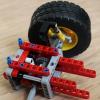
[Ideas contest] Volvo Hare 20XX FR
Jurss posted a topic in LEGO Technic, Mindstorms, Model Team and Scale Modeling
As my entry for Lego Ideas contest is approved, so I can now post something also here. Description Volvo Hare 20XX FR - is bulldozer. 20XX stands for production year, FR - fusion reactor. Fusion reactor is most promising energy producing technology. This maachine has compact version. Main operation is autonomous (programmed for particular construction area). I still think, that in some situations direct guidence still will is needed, so there is openable cabin for those cases. Model is really playable: it "rolls" when pushed, it has tilting (adjustable angle) showel (lower knob at the back), it has risable showel (upper knob at the back), tracks are tensioned using small shock absorbers, openable cabin (by hand), to see inside, only two pins 32045 should be pulled out, and then it is possible to open body. All the functions are done by small actuators, which represents electrical actuators on real machine. Normal (automated) operation Manual operation (cabin open) Some internals And, of course -
Hello, I present you my latest model: Starting from the 42053 set, I decided to add some improvements and make it remote controlled with linear actuators and PF. The undercarriage is very similar to the original, with manual functions. Main mods are double wheels, and some aesthetic adjustments. The Power functions components are located in the upper-structure, except one motor which is in the boom. 1M motor for rotation of the upper-structure 1XL motor for the main boom 1M motor for the third section of the boom 1M motor for the bucket There is also a fake linear actuator to adjust the second section of the boom. I used this solution because this adjustable boom is more common in the real EW160E. Changeable buckets with quick-coupler: Access to the battery box: Power button with easy access: More photos: Video coming soon!!
-
Here is my Let's Build for the upcoming (08/2018) #42081 Volvo Konzept-Radlader ZEUX.Enjoy!
- 19 replies
-
- myheadz
- lego technic
-
(and 3 more)
Tagged with:
-

[MOC] Telehandler (model c for 42053)
Hogwartus posted a topic in LEGO Technic, Mindstorms, Model Team and Scale Modeling
I' ve decided to make an alternative model for 42053 Volvo EW 160E set. Finally made a telehandler. Video: Functions: - 4 wheel steering - front outdiggers - pneumatics with manual pump: arm lifting arm extension tilting fork Please watch the video to see this machine in action and for more details. I hope you liked this model.- 31 replies
-

[TC13] Volvo Iron Knight
Jurss posted a topic in LEGO Technic, Mindstorms, Model Team and Scale Modeling
This is 3rd thing I tried to build for TC13. For my own surprise, this was very fast (started just yesterday afternoon). Volvo Iron Knight (if somebody here doesn't know) My model has two pullback motors working fake 4cyl engine it is almost in scale with tyres Some bad video -
This is my Volvo fh16 750 rc moc. The main goal was to create a huge 1:10 scale model with less funktions but very strong and fast for this size. the propulsion from lego dirt crusher is fixed long side and the batterybox is in the front
-
With this MOC I wanted to create the feeling of a working class area in Sweden during the 70s/80s. The car is a Volvo 242 DL from 1975. Hope you like it!
-

[MOC] Volvo excavator [video online]
steph77 posted a topic in LEGO Technic, Mindstorms, Model Team and Scale Modeling
Here I am again. This time the subject is one of the very usual kind: one PFS IR commanded excavator. They are many exemples of perfect excavator on the web...but I just wanted mine, of my own design. So I study it from A to Z and I had to answer many of the questions that many people answer before.Surprisingly, I do not answer the same at some of them :) But first this is what we are talking about: This model as been design in one only goal : a maximum of fun to play with it. In order to match that goal, each and every motor Is directly connected to each function. No mechanics in there. The function are ultra classical : drive, steer, rotate and the 3 movements of the arm. I make use of L motor for the tracks and lifting main arm. Other are medium size motors. I also choose to keep it as compact as possible. The main issue I find on many creation on the web is a too big body resulting in a too big arm. Too big arm need lots of power and often be very slow to move. I try to get what I think is the best compromise in size and use of existing motors. (No pipa I do not have RC ones :) ) The tracks gives the global scale. As you see the BB is in the lower part of the structure. This is due to compactness of the upper part but also for better design of this last spoken upper part. As the excavator rolls only on flat surfaces, no use of any suspension in it... view from the downside the tracks are well integrated, and even with the BB there is a good ground clearance of 3T wich is very good. I also try to implement good action range at the arm: And also small details that makes it looks good, like 3 sets of lights, toolbox, ... Back view, easy acces to the BB to swictch on/off and replace (often:) ) batteries The top part is designed so replacing M motor by Large one is easy (I do command two of them, awaiting arrival) So here it is, not the Moc of the year for sure, but sometimes it's good to achieve some simple goals. As expected and designed for, this one is very fun to play with. Hope you'll enjoy it Steph. -
REVIEW - 42030 - VOLVO L350F WHEEL LOADER INTRODUCTION The Nuremberg Toy Fair is always an exciting event when it comes to revealing new LEGO sets. This year was no exception. We finally got to see visuals of the upcoming Technic Flagship. This time LEGO teamed up with Volvo to create an impressive version of the Volvo L350F Wheel Loader. In this review we will find out how TLG's interpretation compares to the actual Wheel Loader and whether it's worth the whopping 220 euro you need to fork out to own this bad boy. The designer behind this model is Uwe Wabra, who has designed other great models like the iconic 8258 Crane Truck and the 8285 Tow Truck. It took him about eight months to design the Volvo L350F. Volvo Spirit Magazine "The Nuremberg Toy Fair in February saw global toy giant the LEGO Group unveil its latest flagship model from LEGO®Technic. With 1,600 individual pieces and the largest individual element ever created for the brand, the Volvo L350F wheel loader is not simply one of the company’s 2014 star performers – it is just as impressive as the real-life machine it is based upon." Read more... Volvo Press Release Volvo Construction Equipment and LEGO® Technic have joined forces to create a miniature remote-controlled L350F Wheel Loader in Volvo livery that not only drives, steers, lifts and loads just like the real thing it also converts into an equally impressive hauler. Read more... Credits Before we continue I would like to thank LEGO for providing the set and the possibility to publish this Exclusive review. Furthermore I would like to thank Volvo and Superkalle (our LDD Moderator) for giving me some very useful Volvo insights. All images can be clicked for hi-res versions. SET INFORMATION Number: 42030 Title: Volvo L350F Wheel Loader Theme: Technic Released: 2H 2014 Part Count: 1636 Box Weight: 3541 gr Box Dimensions: 57,5 x 47,8 x 12,0 cm Set Price (MSRP): 219.99 EUR DE / 169.99 GBP / 249.99 USD Price per Part: DE 0.134 EUR / UK 0.103 GBP / USA 0.153 USD With a price tag of almost 220 euro, this is the most expensive Technic flagship to date. The average price of 0,134 euro part part immediately makes clear that this is no ordinary Technic set. A high price per part normally indicates that a set has lots of special parts, like motors and other Power Function elements. THE BOX The box measures 57,5 x 47,8 x 12,0 cm which is equal to the height and width of the box for the 42009 Mobile Crane Mk II. The main difference is that this box measures a depth of 12 cm instead of the Crane's 9 cm. The additional 3 cm is necessary for housing the new Bucket, which will be discussed later. The difference in weight between the Crane Mk II (4172 gr) and the Volvo (3541 gr) is about 631 gram which is not that much, taking in account that the Crane has 970 pieces more (2606) than the Volvo (1636). One thing is sure; this box will leave little room for other Christmas presents under the tree later this year! FRONT SIDE The front of the box shows an impressive picture of the model, no surprise here. Like with most bigger models the size of the model is printed on the box. When finished, this model will measure a length of 58 cm and a height of 38.5 cm. The front also shows a Power Functions section stating it has "fully remote-controlled driving and digging functions.". The bottom right shows the large number of Power Function components this set contains. BACK SIDE The back side shows the B-model which is the Volvo A25F Articulated Dump Truck. The preliminary image of the back side explicitly showed an iPad with the digital building app. The iPad didn't make if to the final box, which makes you wonder whether the iPad instructions won't be available at all. Could it be that the size of the B-model is pushing the boundaries of building with the iPad app?! Another possibility is that the iPad app will be available later than the release of this set. INSIDE When opening the flip-up cover some cool facts of the real Volvo are revealed, together with a picture of the Power Functions and a demonstration of the manual functions. There's also a picture to emphasize the green engine. Name: L350F Horse Power: 540 HP (397 kW) Weight: 52 metric tons Bucket Volume: 6,9 m3 INSIDE COVER The inside of the cover is devoted to the Power Functions. Again all the PF elements are shown. Two remote controls are used for operating the boom and driving the vehicle. It's not necessary to switch between these functions. Three small pictures explain how the Power Functions are controlled. SIDE The side of the box shows the actual size of the bucket, which measures a width of 18,2 cm! Now it's clear why the box needed to be bigger than last year's flagship. CONTENTS OF THE BOX The box contains: 14 Bags 1 Booklet 1 Sticker Sheet 1 Bucket 4 Yellow Rims 4 Tires 9 Power Functions Components BAGS The box contains 14 bags in varying sizes. Business as usual so far. BOOKLET One of the first times we encounter a single booklet for a set this size. When you have built the 42009 Crane you might have seen this before. The first production runs of the Crane included 6 booklets, which later changed into a single booklet. I really appreciate a single booklet, since it more or less reflects the size of the model. STICKER SHEET Not only does the sticker sheet contain stickers for the A-model, but it includes stickers for the B-model as well, which is pretty unusual. This does mean that you either need to remove the A-model's stickers when you are building the B-model, or buying a few extra parts dedicted to the B-model's stickers. HIGHLIGHTED PARTS This section describes the unique and/or highlighted parts. We'll start with the massive Bucket which obviously is the star of the show! BUCKET This type of bucket is called a Spade Nose Rock Bucket. It's primary use is lifting blasted rock and the spade nose is to obtain maxium penetration when digging into the gravel. On a real bucket, the teeth are interchangeable, because they wear out. Volvo’s range of buckets is very comprehensive, encompassing buckets for all types of jobs and all types of materials; from rock and stone to ore and wood chips. Type: Spade Nose Rock Bucket Capacities: 1,8 – 7,5 m3 Applications: Hard and stony material, shot rock and where good penetration is needed. Options: Pin/hook-on, bolt-on edge, welded teeth & segments. Using a real Volvo with spade nose bucket, you could easily haul over 200 LEGO Volvo boxes and probably more than 300 LEGO Volvo models. The following two images show a comparison in size with the Bucket formerly known as the Big Bucket. The older big bucket is used in 8265 Front Loader. As you can see the previous version can easily fit inside the Volvo's Spade Nose Bucket. Makes you wonder how big the finished model will be!! The distance between the upper and lower holes for attaching the bucket is 5L, where this is 3,5L for the older bucket. POWER FUNCTIONS COMPONENTS The number of Power Functions components is unprecedented. No other Technic set has such a vast array of PF components. Admittedly, the 8043 Excavator also has 9 PF elements, but that set only contains M-motors. 1x Battery Box 2x Infrared Receiver 2x Remote Control 1x M-motor 1x L-motor 1x XL-motor 1x Servo motor All of the four available types of PF motors are included in this set. The new L-motor and Servo Motor are found in the 9398 Crawler and it's Exclusive Edition counterpart, the 41999 Crawler Exclusive Edition. The L-motor is also available in the beforementioned Crane Mk II. What's special about this set, is the return of the XL-motor. This motor was about to become a rare PF motor, since it hasn't been used in an official set since 2009. The last Technic set it appeared in was the 8258 Crane Truck (also by Uwe Wabra). What I really like about the XL-motor is it's coasting behavior. Coasting is performing a natural deceleration of a motor when the power is removed. In simple words; the motor doesn't immediately stall after you stop applying power to it. This results in fluent vehicle deceleration. The L-motor doesn't coast which results in the vehicle abrubtly stopping. I very much dislike this shocky behavior on the crawler, so I am glad TLG used the XL-motor for propulsion. Although it had probably more to do with the torque (40 N.cm for XL vs 18 N.cm for L) than the coasting behavior. WHEELS For the first time we get to see the Wheel 56mm D. x 34mm Technic Racing Medium, 6 Pin Holes in Yellow, which is great for bigger construction vehicles. TIRES I was hoping the, so called, Unimog tires would make their way into an official flagship set at least once more. So I was glad to see TLG apparently had the same thought and used these great tires for the Volvo again. WHEEL AND TIRE ASSEMBLY Below is a picture of the complete wheel and tire assembly. ENGINE CYLINDERS Technic Engine Cylinders come in two variants, Cylinders with Side Slots and a newer version Cylinders without Side Slots. The newer version only got produced in light bluish grey, up until now. One of the characteristic features of Volvo machines is their green engine color, originating from the Penta Corporation. Volvo was founded in 1927 and the first engines were bought from Penta Corporation who made green engines, and so just shipped the same color to Volvo. In 1935 Volvo bought Penta (which became Volvo Penta, the marine division). The engines were continued to be painted green. All engines back then were petrol engines. Volvo's first diesel, VDA, was made in 1945. From the 1950's some engines were painted red, but mostly these were for Volvo Cars, and were petrol engines. As for production Diesel Engines in heavy machinery and trucks, they have always been painted green since the start. THIN LIFTARMS The Black Thin Liftarm 1x7 is not very special, but it doesn't appear in Technic sets that often. The Yellow Thin Liftarm 1x6 used to be pretty rare, since it was only included in the 8457 Power Puller. However, last year this part got reintroduced in the 42024 Container Truck. The Light Bluish Grey Thin Liftarm 1x5 with Axle Holes on Ends was introduced in Black in 2013. This is the first time this part appears in another color. AXLE AND PIN CONNECTOR The Yellow Axle and Pin Connector #6 - 90 degrees was last used in the Technic 8258 Crane Truck in 2009, until it made it's comeback in 2012 in the 5885 Triceratops Trapper. Just like the XL-motor Uwe Wabra is using this part again in a Technic set. PANELS Finally we can see a small selection of panels. Mostly old style Yellow Panel Curved 11 x 3 with 2 Pin Holes and a single Black Black Panel Curved 11 x 3 with 10 Pin Holes. PART LIST Here's the complete list for all 1636 parts. BUILDING EXPERIENCE Enough with the boring part...let's build a Volvo! CHASSIS You start building the chassis and after a few steps, the pendular rear axle is taking shape. The small turntable proves to be an asset to the Technic parts catalogue. Another useful part is the Steering Portle Axle, which is rapidly becoming the workhorse of big Technic vehicles. Ordinarily it's placed vertically to provide higher ground clearance, but as you can see, it can be used horizontally as well. Here you can see images of the front and rear sections, which will be joined a bit later in the build. The front and rear section joined together. The wheelbase does not reflect the size of the finished model. Here's a picture of the articulation mechanism of the vehicle. PF MOTORS The four motors are equally divided over the front and rear section. Because two of the motors (M and L) are placed in the front section, there's no need to transfer gears or axles from the rear section. Three (M, L and Servo) of the four motors are placed vertically, while the XL-motor is placed horizontally in the back. VOLVO D16E LAE3 ENGINE The Volvo D16E LAE3 is a straight six-cylinder high performance, low emission turbocharged diesel engine with direct injection, air-to-air intercooler and Internal Exhaust Gas Recirculation (I-EGR). The engine has a one piece cylinder head with four valves per cylinder one overhead camshaft. Furthermore, the engine has wet replaceable cylinder liners, replaceable valve guides and valve seats. The Engine with V-ACT (Volvo Advanced Combustion Technology) features split injection, optimized air handling and turbocharger with waste gate. High torque at low engine speed gives the engine its characteristic feature: quick response at low rpms, even under load. The three white Round Pin Connectors with Slot are the engines oil filters. Two of them are normal, high flow filters and the third one is a fine filter that is optimized to catch finer particles, but has a slower flow. When engine load is moderate and oil/lubrication need is also moderate, much of the oil is directed to the fine filter. When the engine is working at maximum, all oil is instead passed through the two normal filters. LOAD SENSING HYDRAULIC SYSTEM The L350F features an intelligent load-sensing hydraulic system. Two variable piston pumps provide exactly the flow rate and pressure required at any given moment in time, distributing the power where it’s needed, when it’s needed. When flow is not required in the hydraulic system, all engine power is diverted to the drivetrain. This provides smoother operation, lower fuel consumption, and more precise control of machine and load. You always get full power, regardless of revs. The LEGO version uses three Linear Actuators instead of an hydraulic system. NOTE I made an error placing the LA. The top LA in the picture below should be flipped, resulting in the attachment point being at the bottom instead of the top. Thanks to Jantjeuh for pointing this out. CHASSIS AND BODYWORK At this point the chassis and bodywork are almost finished. LOADER Z-BAR LINKAGE The L350F is a heavy duty, primary production loader intended for multi-shift, high production applications. High breakout force in the digging position, high lift capacity and fast hydraulic speeds are the essential requirements for a primary production loader. The Z-bar linkage is a field-proven, effective linkage in this loader size class. The refined geometry is the same for both standard and long boom and allows common bucket range with an open design. Below is an image of the Linear Actuators operating the Z-bar linkage. ROTATING LIGHT A small detail I particularly like is the small rotating light on the top of the cabin. Other models use a transparent 2x2 Round Brick which is way too big. This smaller version fits better! STEPS The image of the real Volvo on the inside of the box shows the steps on the left side of the vehicle, while they are mounted on the right side of the LEGO version. After some research I found out that the L350F used to have the steps on both sides of the cab, but it was not a safe solution for the operator when he had to climb up the steps into the cab with a lunch box. So late last year Volvo changed the design and eliminated the steps on the left side and made the steps on the rear fender standard. Another cool feature that Volvo included was the “remote door opener”, so as the operator approaches the machine, he presses the remote door opener and the door opens automatically and the entrance lights shine down on the steps for additional safety when climbing into the cab when it is dark. INFRARED RECEIVERS The infrared receivers have been placed nicely behind the cabin, hardly visible. Although the box states that V2 receivers are included, there is no V2 sign on the ones I found in my set. FINISHED MODEL It took me approximately 7 hours to finish this model. I reckon most of you will finish it in about 6 hours. FRONT VIEW The finished model looks stunning! It's really massive. Even though I love the looks of this model, I can't help wondering why TLG didn't make some wheel caps to fill the rims and make the wheels look more massive too. REAR VIEW The rear looks great as well. In this picture the battery box is clearly visible, but from a normal viewing angle, it's almost hidden from sight. BOTTOM VIEW Just as you would expect. Nothing out of the ordinary to see here. THE GAP The side view of the Volvo is one of my main concerns. While the rear section looks massive and lifelike. The front section looks unfinished, especially the part in front of the cabin. Also, the bottom of the first section of the boom could use some more bricks to make it look more immense, just like the real machine. PARTS LEFT Quite a few parts left, even three Axles (5L, 6L and 7L). Of course nothing the bucket can't handle! FUNCTIONALITY This model has quite a few functions. The main four functions are: Articulated Steering Driving Raising and Lowering the Boom Operating the Bucket Besides these motorized functions, there are some manual features. ARTICULATED STEERING Wheel Loaders typically use articulated steering. Articulated steering is a system by which a four-wheel drive vehicle is split into front and rear halves which are connected by a vertical hinge. The front and rear halves are connected with one or more hydraulic cylinders that change the angle between the halves, including the front and rear axles and wheels, thus steering the vehicle. This system does not use steering arms, king pins, tie rods, etc. as does four-wheel steering. If the vertical hinge is placed equidistant between the two axles, it also eliminates the need for a central differential, as both front and rear axles will follow the same path, and thus rotate at the same speed. Long road trains, articulated buses, and internal transport trolley trains use articulated steering to achieve smaller turning circles, comparable to those of shorter conventional vehicles. Articulated haulers have very good off-road performance. (Wikipedia) Steering is controlled by the Servo Motor. There was some disappointment in the community because the steering looked very jerky in the videos from the Nuremberg Toy Fair. I must admit I didn't like it either. The Servo Motor has two modes, on (in either direction) or off. This means there's no gradual steering mode, it's hard left, hard right or straight on. This is illustrated in the images below. Playing around with the LEGO model, I experienced that the steering indeed is a bit jerky, but for playability it isn't as bad as it seems. A solution with Linear Actuators would have been more realistic. But since the Volvo basically is a kids toy, I can accept the jerky steering. LIFTING THE BUCKET The boom and bucket are also operated using Power Functions. Both the boom and the bucket are operated with the remote and both functions are working properly at a nice speed! LIFTING LOAD The Volvo is powerful enough to lift it's own weight. That no surprise, since it can lift up to 1 kg of load!! ENGINE BAY The engine bay can be opened from various sides for maintenance, like changing the oil filters. Opening the back reveals the big green 6 cylinder engine with the cooling fan. The D16E engine has a hydraulically driven, electronically controlled cooling fan and intercooler of the air/air type. The system not only results in quieter operation, but also lowers the fuel consumption. BATTERY REPLACEMENT Replacing the batteries in the battery box is fairly easy. Remove the two axles with red bush and unlock the black long pin with stop bush and you can easily detach the battery box from the vehicle. COMPARISON WITH 8265 Inevitable is the comparison with it's predecessor; the 8265 Front Loader. For a non-flagship set, the 8265 already was an impressive Front Loader. The following pictures show how big the Volvo actually is. It trumps the old Front Loader in every way. SUMMARY The LEGO Volvo is nothing short of spectacular! I might even go out on a limb by claiming that this is one of the coolest LEGO Technic models....ever! If not THE coolest! True, there are better looking models. True, there are technically more advanced models. However, this models combines a lot of factors, like playability, looks and the sheer size is stupendous. Adding the Volvo brand and stickers is the icing on the cake. My all time favorite Technic model is the 8043 Motorized Excavator, since this model combines, looks, functionality and playability. The Volvo shares the exact same properties, but it contains a lot more cool parts than the Excavator, a wider variety of Power Functions for instance, a gargantuan unique bucket and Unimog wheels. In all fairness; reading my own summary, I can only come to the conclusion that I like the Volvo even more than the Excavator! Even though the price is pretty steep, I would definitely recommend getting this set. PROS Offers lots of playability No need to switch between functions Finished model is massive LEGO Volvo looks like a genuine L350F Gargantuan unique bucket Unimog wheels CONS The gap in front of the cabin Front section looks unfinished compared to the rear section Omission of wheel caps to make the wheels look more massive Jerky steering due to servo motor (minor con) SCORE Design 9: Stunning looks and the sheer size is impressive. Volvo stickers are the icing on the cake. Build 8,5: Very enjoyable build, but nothing too spectacular. Functionality 9: Four different fully remote controlled functions, combined with some manual functions. Playability 9: Fully remote controlled and no need to switch between functions. Parts 10: It doesn't get any better than this. Entire range of PF motors (including XL Motor), Unimog Tires, unique Yellow Rims and much more! Value for Money 8,5: Although the price is pretty steep, you get a lot of bang for your buck. 9 Bucket Size Does Matter! Hope you enjoyed it! Thanks for reading and please rate this set at the top of this topic!
-

MOC VOLVO FH16 750 with A60H dump truck
shineyu posted a topic in LEGO Technic, Mindstorms, Model Team and Scale Modeling
Hi everyone, This is my new MOC; VOLVO FH16 750 with A60H dump truck, there has RC functions, please enjoy photos and video. Thanks for watching. video: \

